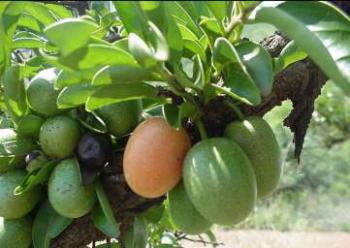Ximenia caffra
Ximenia caffra Sond.
Family: Olacaceae
Common names: large sourplum (Eng.); grootsuurpruim (Afr.); umThunduluka-obmvu (Zulu); Morokologa (Northern Sotho)
SA Tree No: 103
Introduction
The large sourplum is a small tree or shrub with many traditional uses and colourful fruit. It is suited to growing in a bush clump or as part of a boundary screen in the garden to attract fruit-eating birds and various butterflies.

Description
Description
Ximenia caffra is a deciduous tree up to 6 m tall with an untidy open crown. The bark is dark grey and rough, but pale green or brown on younger branches. Branchlets are spine-tipped. Sapwood is white and heartwood is hard and reddish brown. The root system is non-aggressive.
The leathery dark green leaves are often in clusters (fascicles) on short, spur branchlets. They are simple, 60 x 25 mm. Ximenia caffra var. caffra has dense reddish hairs on the leaves and branchlets, whereas var. natalensis has smooth leaves.
The flowers are small, sweet-scented and creamy-green and borne from August to October in single-stem clusters in the axils of the spines or on the dwarf branchlets. They are followed by thinly fleshy, oval, attractive fruits (drupes) which are 25 mm long, glossy, deep red with white spots. These are tart but edible and are relished by birds, other animals and humans. The single large seed inside contains Ximenia oil which has various uses.

Distribution and habitat
Distribution description
The tree is found in woodlands and grasslands and on rocky outcrops and, sometimes on termites mounds. It occurs from Tanzania in the north to KwaZulu-Natal in the south. In South Africa the two varieties have a different distribution pattern with var. caffra occurring in the northern and central regions of Limpopo and var. natalensis is found further east and south in Mpumalanga, Limpopo and KwaZulu-Natal.
Derivation of name and historical aspects
History
Ximenia is named after a Spanish monk, Francisco Ximenez, who wrote about the plants of Mexico in the 17th century. The genusXimenia also occurs in America and the type species of the genus, X. americana, is the only other species that occurs in southern Africa. The species name caffra refers to Kaffraria, an old name for a part of the Eastern Cape.
Ecology
Ecology
Ripe fruits are eaten by birds such as barbets, bulbuls and starlings. The leaves are eaten by mammals including giraffe, impala, kudu, grey duiker, steenbok, bushbuck and eland. The larvae of various butterflies including the Natal bar, Silvery bar, Bowker's sapphire,Saffron sapphire, Brown playboy and Bush scarlet butterfly feed on the leaves.
Uses
Use
Ripe fruit has a vitamin C content of 27%, is high in potassium and contains protein. The seed has a 65% oil content. Fruits have a refreshing sour taste, best eaten when slightly over-ripe, but can also be used for making jam, dessert and jelly. They can be added to porridge. Oil from the seed is used to soften human skins and for softening animal hides. It is also used for lamps. The nuts are also eaten.
A decoction from the leaves is used as a wash to soothe inflamed eyes. Infusions of the roots are used as a remedy for dysentery and diarrhoea and, together with the leaves, are taken for abdominal, pain and bilharziasis. Powdered roots are applied to sores to speed up healing; used in soup, and in beer as an aphrodisiac. Powdered dried leaves are taken orally for fever and infertility, and extracts of the leaves are used as a gargle for tonsillitis, and as a vermifuge. Porridge is made using a decoction of the roots, and eaten once a day for nausea in pregnancy; the root decoction is also taken for infertility.
Growing Ximenia caffra
Grow
It is easily cultivated from fresh seed with a mixture of river sand and compost (5:1). The seeds germinate after 14-30 days and transplanting should take place when the seedlings reach the two-leaf stage. This plant is partly parasitic, and will grow better once in the ground where it can make contact with other plant roots. The growth rate is moderate, up to 0.5 m per year; it can withstand moderate frost and it is drought-resistant, but needs full sun.
References
- Coates Palgrave, K. 1983. Trees of southern Africa, edn 2. Struik, Cape Town.
- Coates Palgrave, M. 2002. Keith Coates Palgrave Trees of southern Africa, edn 3. Struik, Cape Town.
- Palmer, E. & Pitman, N. 1972. Trees of southern Africa. Balkema, Cape Town.
- Van Wyk, B-E. & Gericke, N. 2000. People's plants. Briza Publications, Pretoria.
- Van Wyk, B-E., Van Oudtshoorn, B. & Gericke, N. 1997. Medicinal plants of South Africa. Briza Publications, Pretoria.
- Venter, F. & Venter, J.A. 1996. Making the most of indigenous trees. Briza Publications, Pretoria. Author Joseph K. Baloyi and Yvonne Reynolds Pretoria National Botanical Garden August 2004
Credits
Joseph K. Baloyi and Yvonne Reynolds
Pretoria National Botanical Garden
August 2004
Plant Attributes:
Plant Type: Tree
SA Distribution: Gauteng, KwaZulu-Natal, Limpopo, Mpumalanga, North West
Soil type: Sandy
Flowering season: Spring
PH: Acid, Neutral
Flower colour: Green, Cream
Aspect: Full Sun
Gardening skill: Average
Special Features:
Horticultural zones











Rate this article
Article well written and informative
Rate this plant
Is this an interesting plant?
Login to add your Comment
Back to topNot registered yet? Click here to register.